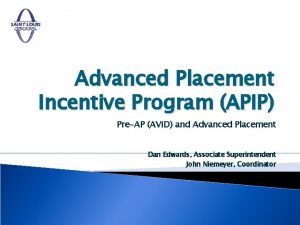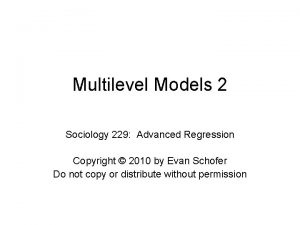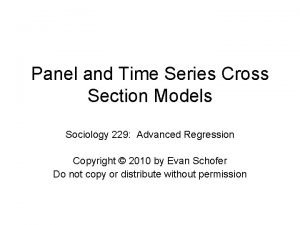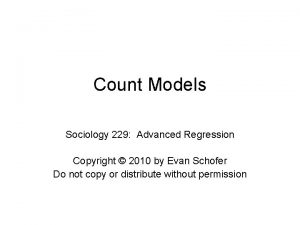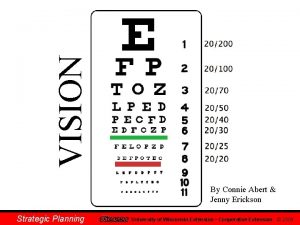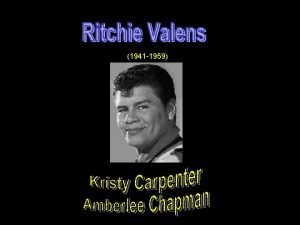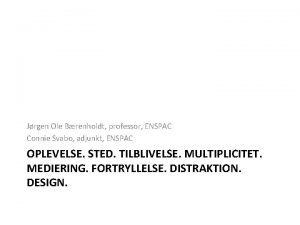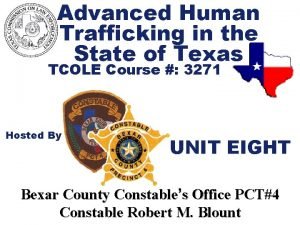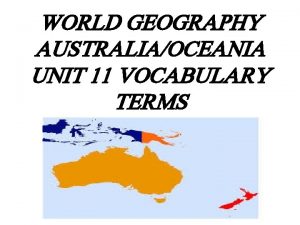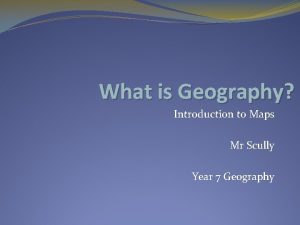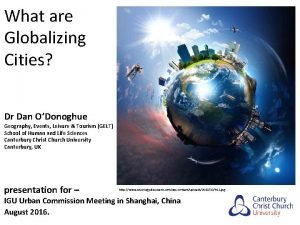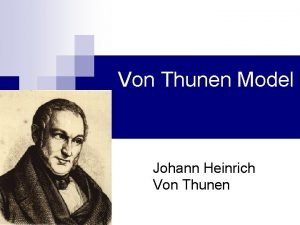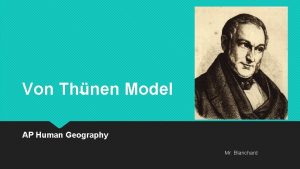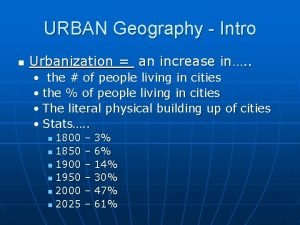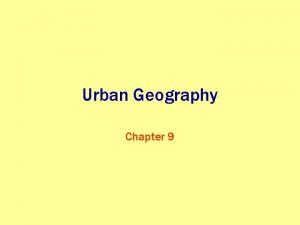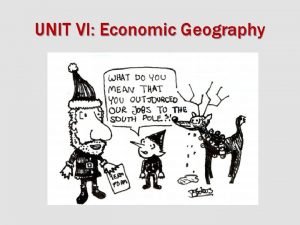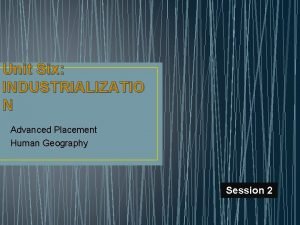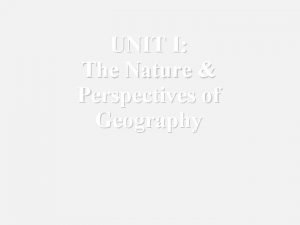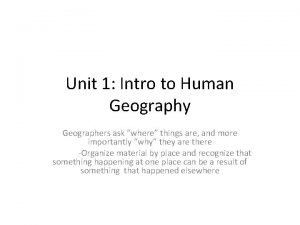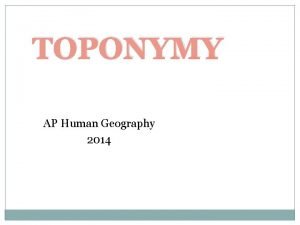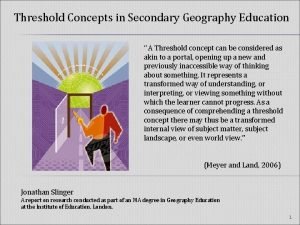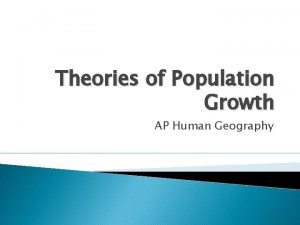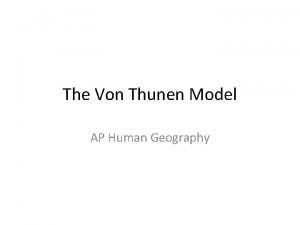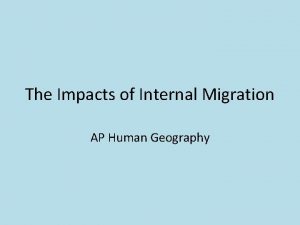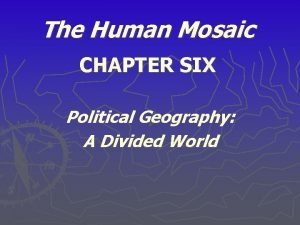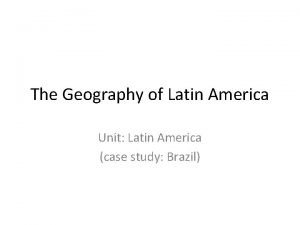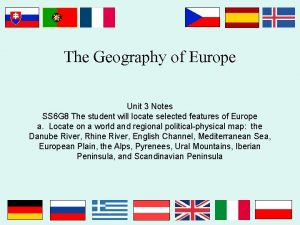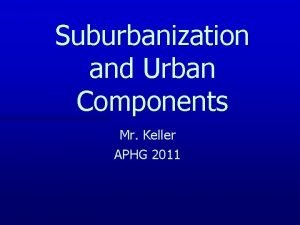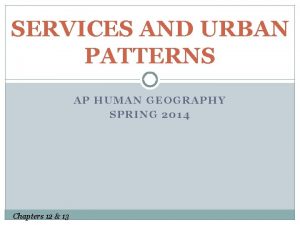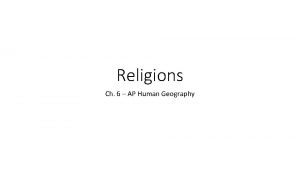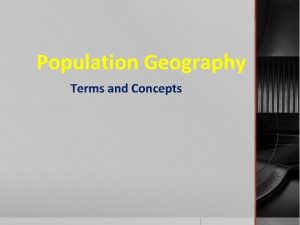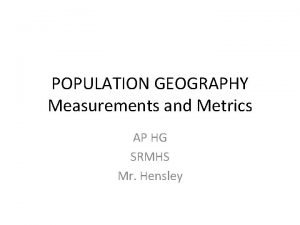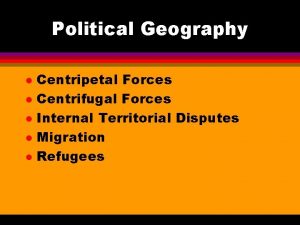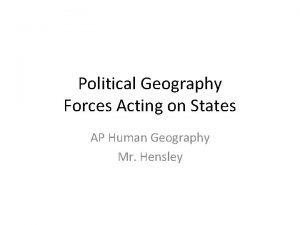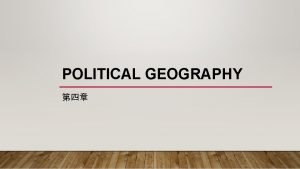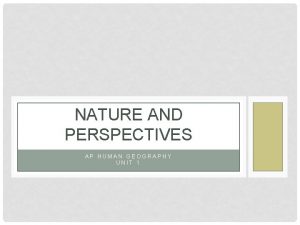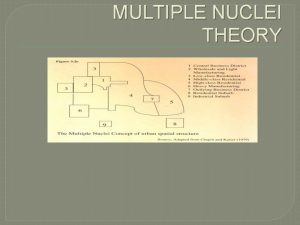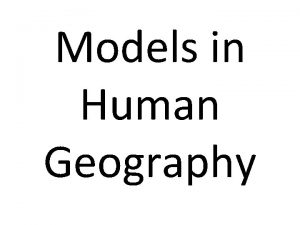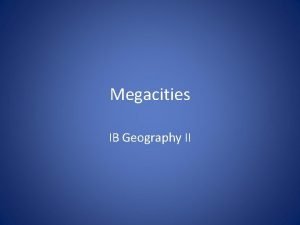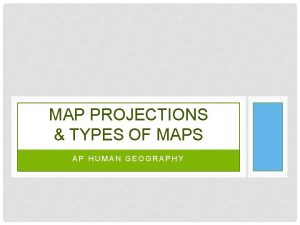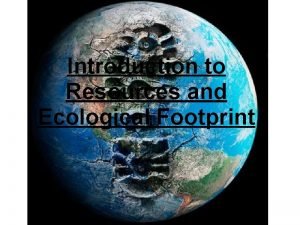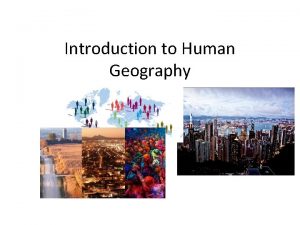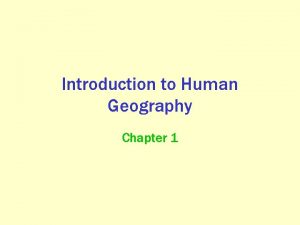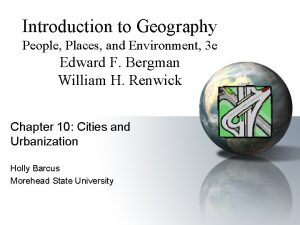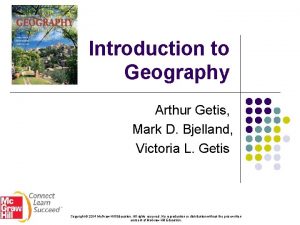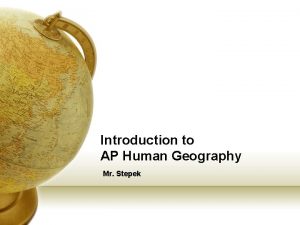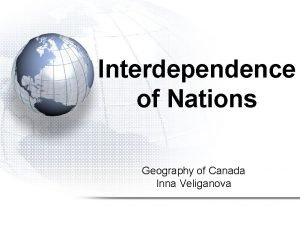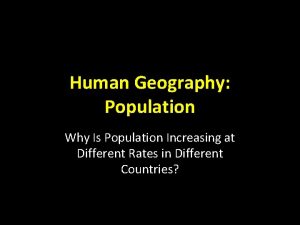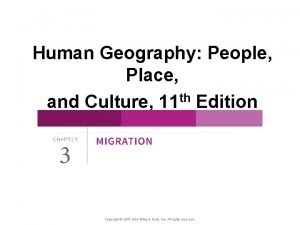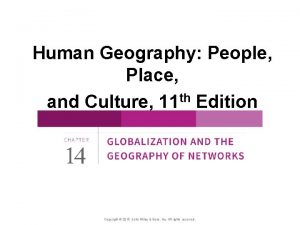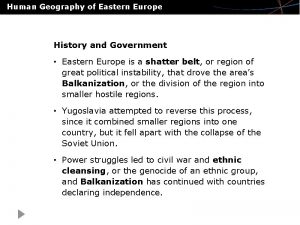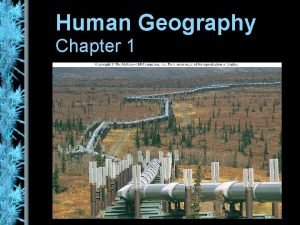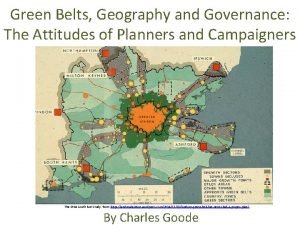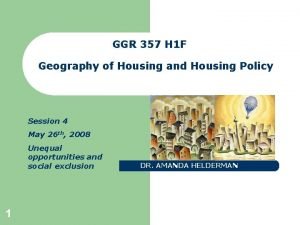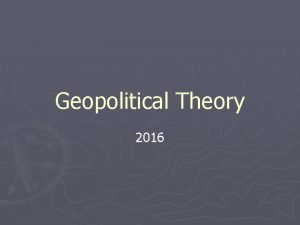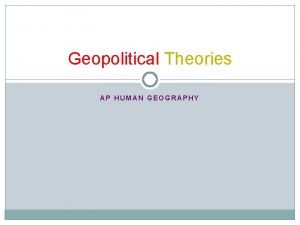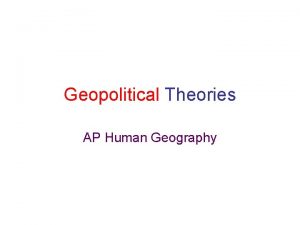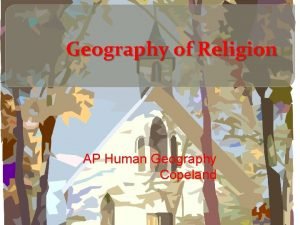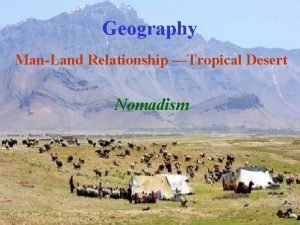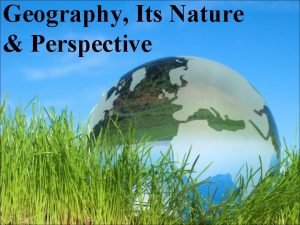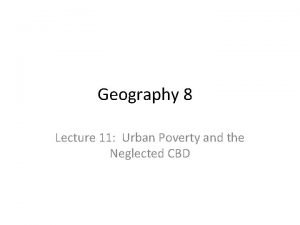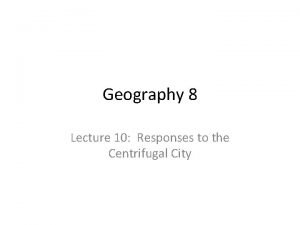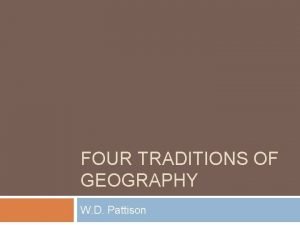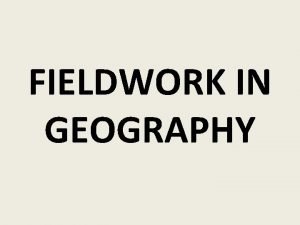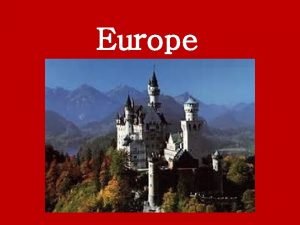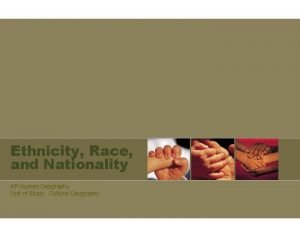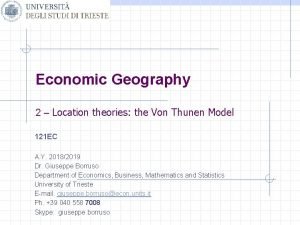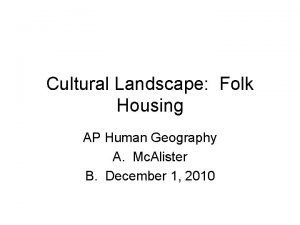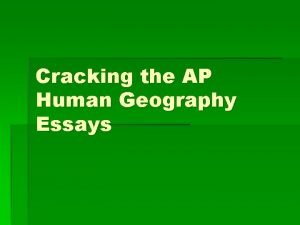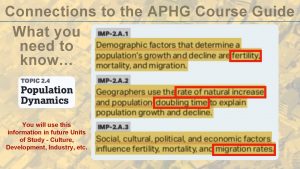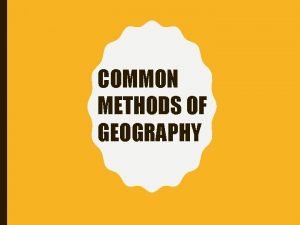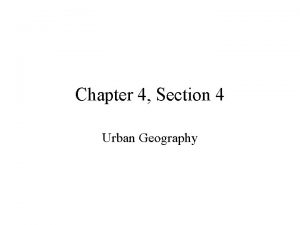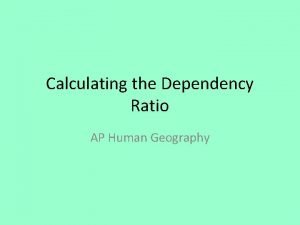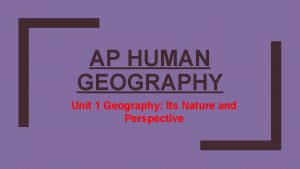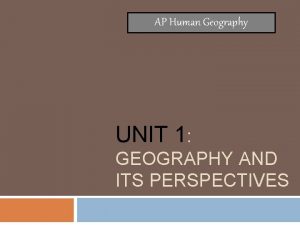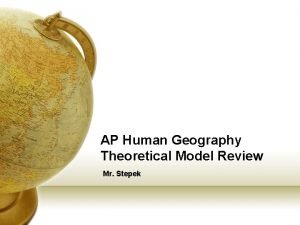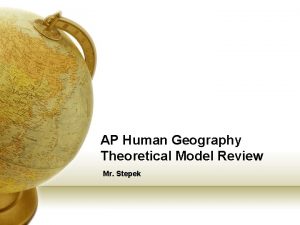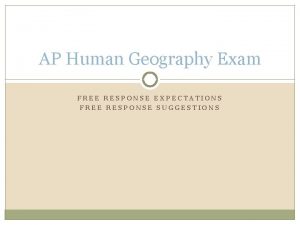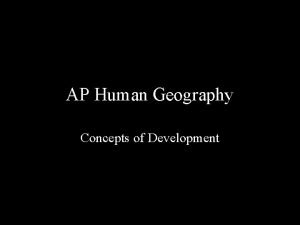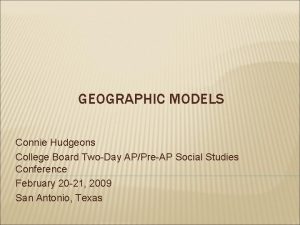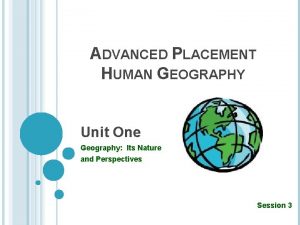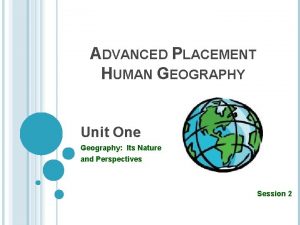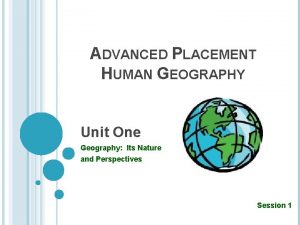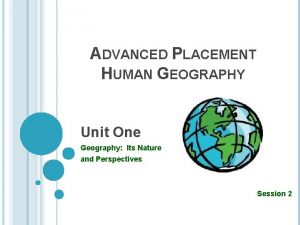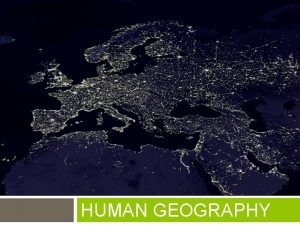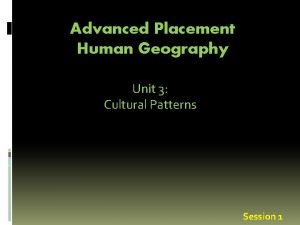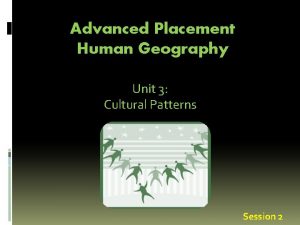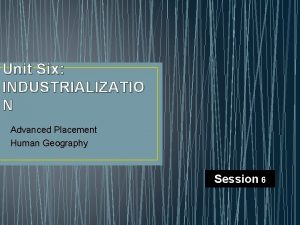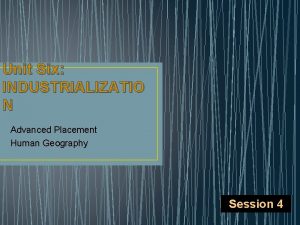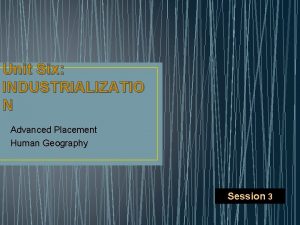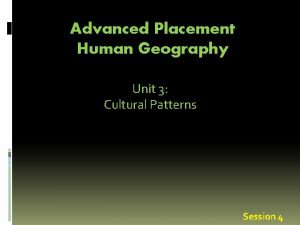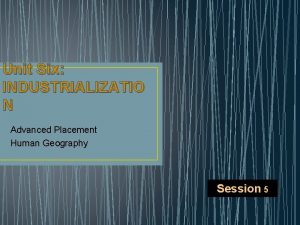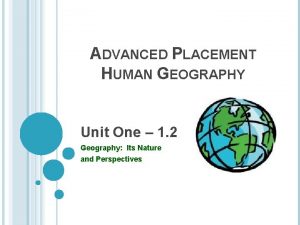GEOGRAPHIC MODELS Connie Hudgeons Advanced Placement Human Geography
























































































































































- Slides: 152

GEOGRAPHIC MODELS Connie Hudgeons Advanced Placement Human Geography Albuquerque High School Albuquerque, New Mexico connie@handywerks. com

Geographer Content Area Model Wegener Pattison Geography: Nature and Plate Tectonic Theory Perspectives Four Geographic Traditions Possibilism Determinism Malthus Population Malthusian Theory Neo-Malthusian Theory Laws of Migration Demographic Transition Model Boserup’s Thesis Sauer Cultural Patterns Cultural Landscape Conrad-Demarest Mac. Kinder Spykman Mahan Rostow Ratzel Wallerstein Political Organization of Space Stages of Empire Building Heartland Theory Rimland Theory Sea Power Theory Model of Economic Development Organic Theory of Nations World Systems Theory Ravenstein Thompson Boserup

Geographer Content Area Model Von Thunen Burgess Boserup Agricultural and Rural Land Use Agricultural Model Concentric Zone Model Boserup’s Thesis Carey Castells & Hall Kondratieff Losch Rostow United Nations Wallerstein Weber Industrialization and Economic Development Gravity Model Space of Flows Technopolis Long Wave Theory Agglomeration/Spatial Influence Model of Economic Development Millennium Development Models Core-Periphery Model Industry Location/Least Cost/Agglomeration Burgess Hoyt Harris-Ullman Christaller Borchert Cities and Urban Land Use Concentric Zone Model Urban Sector Model Multiple Nuclei Model Central Place Theory Stages of Evolution of American Metropolis The Club of Rome EVERYTHING World 3

Geography Its Nature And Perspective

Four Traditions of Geography The Four Traditions were outlined by William Pattison at the NCGE Opening Session on November 29, 1963. Tradition Core Concepts Spatial Tradition Mapping, Spatial Analysis, Boundaries & Densities, Movement & Transportation, Central Place Theory, Areal Distribution. Spatial Patterns Area Studies Descriptions of Regions & Areas, World Regional Geography, International Trends & Relationships, Regional Differences, Chorographic Tradition Man-Land Human impact on Nature, Nature impact on Humans, Natural Hazards, Perception of Environment, Environmentalism, Cultural, Political and Population Geography Earth Science Physical Geography, The Spheres – litho, hydro, atmo, & bio. Earth-Sun interaction, Earth as Home, Geology, mineralogy, paleontology, glaciology, geomorphology & meteorology

Environmental Determinism Definition: The belief that the physical environment has played a major role in the cultural development of a people or locale. Also called environmentalism. Examples: In previous years, environmental determinism was popular and it was acceptable to believe that cultures were ruled by their environment. The well-known contrast between the energetic people of the most progressive parts of the temperate zone and the inert inhabitants of the tropics and even of intermediate regions, such as Persia, is largely due to climate. . . the people of the cyclonic regions rank so far above those of the other parts of the world that they are the natural leaders. Ellsworth Huntington, Principles of Human Geography, 1940

Environmental Possibilism A philosophy seen in contrast to environmental determinism that declares that although environmental conditions do have an influence on human and cultural development, people have varied possibilities in how they decide to live within a given environment. Even possibilism has its limitations, for it encourages a line of inquiry that starts with the physical environment and asks what it allows. Yet human cultures have frequently pushed the boundaries of what was once thought to be environmentally possible by virtue of their own ideas and ingenuity. Harm de Blij, Human Geography, 7 th ed. , page 33.

PLATE TECTONICS The Best Source of information USGS This Dynamic Earth: The Story of Plate Tectonics http: //pubs. usgs. gov/gip/dynamic. html

http: //pubs. usgs. gov/gip/dynamic/graphics/Fig 2 -5 globes. gif

Population

World Population World population is in a state of very rapid increase. This may be expressed is various ways. On arithmetic scale population appears to be in an explosive stage. http: //www. hort. purdue. edu/newcrop/tropical/lecture_14/lec_14. html

If we plot human population on a log scale there appears to be 3 phases brought about by levels of historical development:

Thomas Malthus Happy 248 th B-Day – Feb 14 or 17, 1766!! In 1798, hastily written text, An Essay on the Principle of Population as it Affects the Future Improvement of Society, with Remarks on the Speculations of Mr. Godwin, M. Condorcet, and Other Writers, was published by Thomas Robert Malthus. Often known today as the "patron saint of demography" and while some argue that his contributions to population studies were unremarkable, Malthus did indeed cause population and demographics to become a topic of serious academic study.

Two Views on Populations Alarmists - Population bomb Mass starvation (Paddock, 1975 wrote Famine 1979) Major world issue, the only real issue is the disappearance of world surpluses Technocrats - Science and technology will find the way. Famines are decreasing. People are better fed than ever before. World food supply shows the same graph as world population. Population Dynamics Growth is determined by: Biological capacity of woman to bear children Natural length of life Ecological factors that Produce food Determine fertility Determine mortality

Malthus noted that food production increases arithmetically (e. g. 1, 2, 3, 4) while human population increases geometrically (e. g. 1, 2, 4, 8). Since human population is determined ultimately by the food supply, Malthus thought population would be brought in balance only by famine and pestilence. He never foresaw the tremendous growth of food with modern agriculture due to new lands and the scientific revolution. Malthusian predictions have not yet come to past.

According to Thomas Malthus, preventative checks are those that affect the birth rate and include marrying at a later age (moral restraint), abstaining from procreation, birth control, and homosexuality. Malthus, a clergyman in the Church of England, considered birth control and homosexuality to be vices and inappropriate (but nonetheless practiced). Positive checks are those that increase the death rate. These include disease, war, disaster, and finally, when other checks don't reduce population, famine. Malthus felt that the fear of famine or the development of famine was also a major impetus to reduce the birth rate. He indicates that potential parents are less likely to have children when they know that their children are likely to starve.

Malthusian Checks http: //www. ditext. com/flew/malthus-1. jpg

Diagram of Malthus's theory of population growth. http: //library. thinkquest. org/C 002291/high/future/images/malthusgraph. gif

Population Growth Malthus Marx http: //www. southtexascollege. edu/nilsson/4_ES_Exams_f/chapter 7/f 7 -04_a_thomas_malthus_. jpg

"In October 1838, that is, fifteen months after I had begun my systematic inquiry, I happened to read for amusement Malthus on Population, and being well prepared to appreciate the struggle for existence which everywhere goes on from long- continued observation of the habits of animals and plants, it at once struck me that under these circumstances favorable variations would tend to be preserved, and unfavorable ones to be destroyed. The results of this would be the formation of a new species. Here, then I had at last got a theory by which to work". Charles Darwin, from his autobiography. (1876) This often quoted passage reflects the significance Darwin affords Malthus in formulating his theory of Natural Selection. What "struck" Darwin in Essay on the Principle of Population (1798) was Malthus's observation that in nature plants and animals produce far more offspring than can survive, and that Man too is capable of overproducing if left unchecked. Malthus concluded that unless family size was regulated, man's misery of famine would become globally epidemic and eventually consume Man. Malthus' view that poverty and famine were natural outcomes of population growth and food supply was not popular among social reformers who believed that with proper social structures, all ills of man could be eradicated.

Neo Malthusian Theory Those who continue to agree with Malthus’ concerns are sometimes called Neo Malthusians. They point out that human suffering is now occurring on a scale that Malthus could not have imagined. They argue that it is not enough to assert that the current state is merely an inevitable stage in world population. The Neo-Malthusian population theory claims that poor nations are stuck in a cycle of poverty that will not be broken without some type of preventative measures. Malthus's model is based upon a relationship between both population growth as well as economic development. Some empirical studies indicate that the population model was flawed because the two main variables (population growth and level of per-capita income) have no clear link.

Boserup’s Thesis Ester Boserup was a Danish economist and writer. She wrote several books covering world economics. Her most notable book is The Conditions of Agricultural Growth: The Economics of Agrarian Change under Population Pressure (Chicago, Aldine, 1965). This book presented a "dynamic analysis embracing all types of primitive agriculture. " In doing so, she upended the assumption dating back to Malthus’s time (and still held in many quarters) that agricultural methods determine population via food supply.

Boserup’s research indicated that population determines agricultural methods. Boserup’s theory opposes Malthus by saying that the agricultural methods depend on the size of the population. Malthus states that in times when food is not sufficient for everyone, the extra people will have to die. Boserup states that in those times of pressure people will find out ways to increase the productivity of food by increasing workforce, machinery, fertilizers, etc. A major point of her book is that "necessity is the mother of invention". .

Malthus Boserup http: //www. geographyalltheway. com/igcse_geography/population_settlement/population/imagese tc/malthus_graph. jpg

Although Boserup is widely regarded as being anti-Malthusian, both her insights and those of Malthus can be comfortably combined within the same general theoretical framework. She argued that when population density is low enough to allow it, land tends to be used intermittently, with heavy reliance on fire to clear fields and fallowing to restore fertility (often called slash and burn farming). Numerous studies have shown such methods to be favorable in total workload and also efficiency (output versus input). In Boserup’s theory, it is only when rising population density curtails the use of fallowing (and therefore the use of fire) that fields are moved towards annual cultivation.

Contending with insufficiently fallowed, less fertile plots, covered with grass or bushes rather than forest, mandates expanded efforts at fertilizing, field preparation, weed control, and irrigation. These changes often induce agricultural innovation but increase marginal labor cost to the farmer as well: the higher the rural population density, the more hours the farmer must work for the same amount of produce. Therefore workloads tend to rise while efficiency drops. This process of raising production at the cost of more work at lower efficiency is what Boserup describes as "agricultural intensification". The theory has been instrumental in understanding agricultural patterns in developing countries, although it is highly simplified and generalized.

This website has a Resources section with articles relating to Malthus, Erlich, the Club of Rome, Boserup, and Simon. There are several web-based activities covering population theories. http: //www. geographyalltheway. com/ib_geography/ib_r esources/ib_population_resources. htm

Demographic Transition Model The Demographic transition model (DTM) is a model used to represent the process of explaining the transformation of countries from high birth rates and high death rates to low birth rates and low death rates as part of the economic development of a country from a pre-industrial to an industrialized economy It is based on an interpretation begun in 1929 by the American demographer Warren Thompson of prior observed changes, or transitions, in birth and death rates in industrialized societies over the past two hundred years. Originally designed with three stages, it is now common to see the model with five or more stages.

Sociological Explanation of Population Growth Demographic transition is the change from a low population growth rate based on high or medieval birth and high death rates to a low population growth rate based on low (modern) birth and death rates. During this transition, death rate starts to drop faster than birth rate which leads to an explosive population increase. Birth rate is the number of live births per 1000 population. In l 875 birth rate was in the high 30 s; in l 930 the birth rate declined to between 15 and 20 (1. 5– 2. 0%).

The transition involves four stages, or possibly five. In stage one, pre-industrial society, death rates and birth rates are high and roughly in balance. In stage two, that of a developing country, the death rates drop rapidly due to improvements in food supply and sanitation, which increase life spans and reduce disease. These changes usually come about due to improvements in farming techniques, access to technology, basic healthcare, and education. Without a corresponding fall in birth rates this produces an imbalance, and the countries in this stage experience a large increase in population.

In stage three, birth rates fall due to access to contraception, increases in wages, urbanization, a reduction in subsistence agriculture, an increase in the status and education of women, a reduction in the value of children's work, an increase in parental investment in the education of children and other social changes. Population growth begins to level off. During stage four there are both low birth rates and low death rates. Birth rates may drop to well below replacement level as happened in countries like Germany, Italy, and Japan, leading to a shrinking population, a threat to many industries that rely on population growth. As the large group born during stage two ages, it creates an economic burden on the shrinking working population. Death rates may remain consistently low or increase slightly due to increases in lifestyle diseases due to low exercise levels and high obesity and an aging population in developed countries.

THE CLASSIC STAGES OF DEMOGRAPHIC TRANSITION Stage 1 Stage 2 Stage 3 Stage 4 Birth rate Natural increase Death rate Time Note: Natural increase is produced from the excess of births over deaths. Lesson Plan: The Demographic Transition, Activity One

Five stage Model


The original Demographic Transition model has just four stages. Some theorists consider that a fifth stage is needed to represent countries that have undergone the economic transition from manufacturing based industries into service and information based industries called deindustrialization. Countries such as United Kingdom (the earliest nation universally recognized as reaching Stage Five), Germany, Italy, Spain, Portugal, Greece, and most notably Japan, whose populations are now reproducing well below their replacement levels, are not producing enough children to replace their parents' generation. China, South Korea, Hong Kong, Singapore, Thailand Cuba are also below replacement levels, but this is not producing a fall in population yet in these countries, because their populations are relatively young due to strong growth in the recent past.


The population of southern Europe is already falling, and Japan and some of western Europe will soon begin to fall without significant immigration. However, many countries that now have sub-replacement fertility did not reach this stage gradually but rather suddenly as a result of economic crisis brought on by the post-communist transition in the late 1980 s and the 1990 s. Examples include Russia, Ukraine, Romania, and the Baltic States. The population of these countries is falling due to fertility decline, emigration and, particularly in Russia, increased male mortality

As with all models, this is an idealized picture of population change in these countries. The model is a generalization that applies to these countries as a group and may not accurately describe all individual cases. The extent to which it applies to less-developed societies today remains to be seen. Many countries such as China, Brazil and Thailand have passed through the DTM very quickly due to fast social and economic change. Some countries, particularly African countries, appear to be stalled in the second stage due to stagnant development and the effect of AIDS.

Ravenstein: Laws of Migration 1885 The rise of the industrial age during the second half of the nineteenth century revolutionized life and working patterns for millions of people across Europe and North America. The disruptive influence of factories, railroads and economies of scale changed both the nature of opportunity and where it could be found. Millions of people were uprooted from their traditional homes and livelihoods and hit the road in search of a better life or to escape one that had become intolerable. In a paper delivered to the Journal of the Statistical Society in England in 1885, Ravenstein outlined a series of "laws of migration" that attempted to explain and predict migration patterns both within and between nations. Ravenstein's basic laws, and additional laws subsequently derived from his work, continue to serve as the starting point for virtually all serious models of migration patterns over a century later.

1) Most migrants only proceed a short distance, and toward centers of absorption. 2) As migrants move toward absorption centers, they leave "gaps" that are filled up by migrants from more remote districts, creating migration flows that reach to "the most remote corner of the kingdom. “ 3) The process of dispersion is inverse to that of absorption. 4) Each main current of migration produces a compensating countercurrent. 5) Migrants proceeding long distances generally go by preference to one of the great centers of commerce or industry. 6) The natives of towns are less migratory than those of the rural parts of the country. 7) Females are more migratory than males.

At the heart of Ravenstein's emerging migration model were the concepts of absorption and dispersion. He defined a county of absorption as having "a population more or less in excess of the number of its natives enumerated throughout the kingdom. " In other words, it was a country that on the whole took in more people than it gave up. A county of dispersion, then, would be one of the counties that on the whole gave up population over time, or in Ravenstein's words, "the population [of the county] falls short of the number of [its] natives enumerated throughout the kingdom. "

Ravenstein's laws immediately created a stir, with some complaining that he had identified patterns of migration, but that this was not the same as discovering "natural laws. " Four years, later, he presented another paper that looked at migration patterns elsewhere in Europe and North America, in which he highlighted an exception to migration patterns based upon the American frontier experience. He noted that people are more willing to travel long distances to occupy unsettled land than they would in a country more fully settled, as was the case in the United Kingdom. Modified from www. csiss. org

CULTURE

Sauer & Cultural Landscape The geographer Otto Schluter is credited with having first formally used “cultural landscape” as an academic term in the early twentieth century. In 1908, Schluter argued that by defining geography as a Landschaftskunde (landscape science) this would give geography a logical subject matter shared by no other discipline. He defined two forms of landscape: the Urlandschaft (trans. ‘natural landscape’) or landscape that existed before major human induced changes and the Kulturlandschaft (trans. 'cultural landscape') a landscape created by human culture. The major task of geography was to trace the changes in these two landscapes.

Carl Sauer was probably the most influential in promoting and developing the idea of cultural landscapes. Sauer was determined to stress the agency of culture as a force in shaping the visible features of the Earth’s surface in delimited areas. Within his definition, the physical environment retains a central significance, as the medium with and through which human cultures act. His classic definition of a 'cultural landscape' reads as follows: “The cultural landscape is fashioned from a natural landscape by a cultural group. Culture is the agent, the natural are the medium, the cultural landscape is the result“

Since Schulter's first formal use of the term, and Sauer's effective promotion of the idea, the concept of 'cultural landscapes has been variously used, applied, debated, developed and refined within academia. In 1992, the World Heritage Committee elected to convene a meeting of the 'specialists' to advise and assist redraft the Committee's Operational Guidelines to include 'cultural landscapes' as an option for heritage listing properties that were neither purely natural nor purely cultural. Since then, UNESCO has created a list of 878 World Heritage Sites to preserve humanity’s heritage. http: //whc. unesco. org/en/list

Sauer was a fierce critic of environmental determinism, which was the prevailing theory in geography when he began his career. He proposed instead an approach variously called "landscape morphology" or "cultural history. " This approach involved the inductive gathering of facts about the human impact on the landscape over time. Sauer rejected positivism, preferring particularist and historicist understandings of the world. He drew on the work of anthropologist Alfred Kroeber and was accused of introducing a "superorganic" concept of culture into geography. Sauer expressed concern about the way modern capitalism and centralized government were destroying the cultural diversity and environmental health of the world.

http: //www. harpercollege. edu/mhealy/geogres/maps/worldgif/wwhearth. gif

A portion of Clark Wissler's map of the culture areas of the Native American United States. The map, which is designed to highlight similarities in food gathering techniques, lists seven culture areas: the woodsmen of the eastern forests, the hunters of the plains, the Navaho shepherds, the Pueblo farmers, the desert dwellers, the seed gatherers and the northern fishermen. Map Source: "Three Maps of Indian Country, " United States Bureau of Indian Affairs, Lawrence, Kansas: Haskell Institute (1948).

National Geographic Expeditions Lesson Plan The Evolution of Cultural Landscape http: //www. nationalgeographic. com/xpeditions/lessons/06/g 912/cultural. html

POLITICAL

Mac. Kinder Sir Halford John Mackinder was a British geographer who wrote a paper in 1904 called "The Geographical Pivot of History. " Mackinder's paper suggested that the control of Eastern Europe was vital to control of the world. He formulated his hypothesis as: Who rules East Europe commands the Heartland Who rules the Heartland commands the World-Island Who rules the World-Island commands the world Mackinder's Heartland (also known as the Pivot Area) is the core area of Eurasia, and the World-Island is all of Eurasia (both Europe and Asia).


According to Mackinder, the earth's land surface was divisible into: • The World-Island, comprising the interlinked continents of Europe, Asia, and Africa. This was the largest, most populous, and richest of all possible land combinations. • The offshore islands, including the British Isles and the islands of Japan. • The outlying islands, including the continents of North America, South America, and Australia. • The Heartland lay at the centre of the world island, stretching from the Volga to the Yangtze and from the Himalayas to the Arctic. Mackinder's Heartland was the area ruled by the Russian Empire and then by the Soviet Union, minus the area around Vladivostok.

Spykman In 1942, Nicholas Spykman proposed a theory which countered Mackinder's Heartland Theory. Spykman stated that Eurasia's Rimland, the coastal areas or buffer zone, is the key to controlling the World Island, not the heartland. Today we look at the Rimland in terms of its economic strength and potential. While the book does deal with economic issues, what has become known as the Rimland Theory deals primarily with military intervention, control and conquest of the Old World. The theory was later expanded and refined in a series of lectures which were transcribed into the book "The Geography of the Peace".

The Rimland is the concept of a geographic area adjacent to the “Heartland” that is comprised of most of Europe, the Middle East, the Indian sub-continent, Southeast Asia, and the Far East. This area forms an enveloping geographic ring around Mackinder’s “Heartland. ” In other words, the Rimland essentially surrounds the central, core region of Eurasia. http: //www. globalresearch. ca/article. Pictures/Spykman%20 Rimland%20(1944). jpg

Conrad-Demarest Model of Empires In 1988, Geoffrey Conrad and Arthur Demarest published Religion and Empire the Dynamics of Aztec and Inca Expansionism: The Dynamics of Aztec and Inca Expansionism. Conrad and Demarest have worked in Mesoamerica for 25 years, leading archaeological excavations and expeditions. They are considered two of the world's leading experts on the Meso. American empires and related anthropological theory. Their model, based on the Aztecs, can be applied to most empire analysis. 1. Necessary preconditions for the rise of empires-the region must have: a) State-level government b) High agricultural potential of the environment c) An environmental mosaic d) Several small states with no clear dominant state (power vacuum) e) Mutual antagonism among those states f) Adequate military resources (or a military or technological advantage)

2. States succeed in empire building if they have an ideology that promotes personal identification with the state, empire, leader, conquest, and/or militarism 3. Characteristics of well-run empires a) Build roads and transportation systems, canals, ports, etc. b) Trade increases c) Cosmopolitan cities-art and education flourish d) Effective bureaucracy to ensure communication, collect oversee coinage, ensure the emperor's laws are enforced e) Common official language (communication) f) System of justice, law for entire empire g) Citizenship or rights extend in some degree to conquered; be some buy-in taxes, must

4. Major results of empire: a) Economic rewards, especially in the early years, redistributed to elite and trickles down to other classes (esp. merchants, scribes, etc. ) b) Relative stability and prosperity c) Population increase 5. Empires fall because: a) Failure or leadership; focus on wealth, etc. not the needs of the state b) Ideology of expansion and conquest leads to attempting new conquests beyond a practical limit: overstretching of bureaucracy, military, resources, communication c) Lack of new conquests erodes economic base and lessens faith in ideology that supported the empire d) Rebellions from within/ challenges from without

Mahan Although a brilliant naval historian and noted theorist on the importance of sea power to national defense, Alfred Thayer Mahan hated the sea and dreaded his duties as a ship's captain. Mahan was perhaps the most celebrated naval historian of his era, an influential promoter of United States naval and commercial expansion during America's rise to world power in the late nineteenth century. As the author of numerous articles and books, including the landmark The Influence of Sea Power Upon History, 1660 -1783, Alfred Thayer Mahan was widely regarded as a brilliant naval theorist. From his writings, readers would never have guessed, however, that the renowned champion of the United States Navy hated the sea, and while an active-duty naval officer, lived in constant fear of ocean storms and colliding ships.

Mahan’s theory was based on three critical elements of seapower: (1) (2) (3) weapons of war, primarily battleships and their supply bases; a near monopoly of seaborne commerce from which to draw wealth, manpower, and supplies; and a string of colonies to support both of the above. His theories, however, rested on two serious fallacies. First, his over-reliance upon the notion of concentrating forces falsely denied the importance of coastal defense, and undervalued commerce raiding. These assumptions forced strategists to search for a decisive, war‐winning battle, often in vain. Second, he overstated the strategic benefits of controlling seaborne commerce and colonies.

In peacetime, the components of empire frequently contributed to wealth and consequently to long‐term strength, in war they often proved to be liabilities. Mahan's timeless principles, as enacted along the lines of late‐nineteenth‐century navalism, had the effect of turning America's strategic vision of itself on its side and created a world naval power. Through the implementation of Mahan’s theory, instead of remaining an unassailable continental power with maritime reach, England became an overstretched maritime power with global vulnerabilities.

Wallerstein – World Systems Theory The most well-known version of the world-system approach has been developed by Immanuel Wallerstein analyzed the World System as follows: "A system is defined as a unit with a single division of labor and multiple cultural systems. "

Characteristics of the modern world-system Proponents of world-systems analysis see the world stratification system the same way Karl Marx viewed class (ownership versus non-ownership of the means of production) and Max Weber viewed class (which, in addition to ownership, stressed occupational skill level in the production process). The core nations primarily own and control the major means of production in the world and perform the higher-level production tasks. The periphery nations own very little of the world’s means of production (even when they are located in periphery nations) and provide less-skilled labor.

Like a class system with a nation, class positions in the world economy result in an unequal distribution of rewards or resources. The core nations receive the greatest share of surplus production, and periphery nations receive the least. Furthermore, core nations are usually able to purchase raw materials and other goods from noncore nations at low prices, while demanding higher prices for their exports to noncore nations.

Chirot (1986) lists the five most important benefits coming to core nations from their domination of periphery nations: Access to a large quantity of raw material Cheap labor Enormous profits from direct capital investments A market for exports Skilled professional labor through migration of these people from the noncore to the core

Core nations are: • The most economically diversified, wealthy, and powerful • Highly industrialized • Tend to specialize in information, finance and service industries • Produce manufactured goods rather than raw materials for export • More often in the forefront of new technologies and new industries. • Have more complex and stronger state institutions to manage economic affairs internally and externally • Have a sufficient tax base so these state institutions can provide infrastructure for a strong economy • Have more means of influence over noncore nations • Relatively independent of outside control

Periphery nations are • Least economically diversified • Tend to depend on one type of economic activity, such as extracting and exporting raw materials to core nations • Are often targets for investments from multinational (or transnational) corporations from core nations that come into the country to exploit cheap unskilled labor for export back to core nations • Tend to have a high percentage of their people that are poor and uneducated. • High Inequality because of a small upper class that owns most of the land has profitable ties to multination corporations • Have relatively weak institutions with little tax base to support infrastructure development • Tend to be extensively influenced by core nations and their multinational corporations. Many times they are forced to follow economic policies that favor core nations and harm their economic prospects

According to world systems theory, a core nation is dominant over all the others when it has a lead in three forms of economic dominance over a period of time: Productivity dominance allows a country to produce products of greater quality at a cheaper price compared to other countries. Productivity dominance may lead to trade dominance. Now, there is a favorable balance of trade for the dominant nation since more countries are buying the products of the dominant country than it is buying from them. Trade dominance may lead to financial dominance. Now, more money is coming into the country than going out. Bankers of the dominant nation tend to receive more control of the world’s financial resources.

Ratzel Freidrich Ratzel (1844 -1904) was a German anthropologist who was a significant contributor to nineteenth-century theories of diffusion and migration. He developed criteria by which the formal, non-functional characteristics of objects could be compared, because it would be unlikely that these characteristics would have been simultaneously invented. Ratzel warned that possible migration or other contact phenomena should be ruled out in each case before cross-cultural similarities were attributed to independent invention. He wrote The History of Mankind in 1896, which was said to be "a solid foundation in anthropological study" by E. B. Tylor, a competing British cultural evolutionist (Harris 1968: 383).

Influenced by thinkers like Darwin and zoologist Ernst Heinrich Haeckel, Ratzel published several papers. Among them is the essay Lebensraum (1901) concerning biogeography, creating a foundation for the uniquely German variant of geopolitics: geopolitik. Ratzel’s writings coincided with the growth of German industrialism after the Franco-Prussian war and the subsequent search for markets that brought it into competition with England. His writings served as welcome justification for imperial expansion. Influenced by the American geostrategist Mahan, Ratzel wrote of aspirations for German naval reach, agreeing that sea power was selfsustaining, as the profit from trade would pay for the merchant marine, unlike land power.

Ratzel’s key contribution to geopolitik was the expansion on the biological conception of geography, without a static conception of borders. States are instead organic and growing, with borders representing only a temporary stop in their movement. It is not the state proper that is the organism, but the land in its spiritual bond with the people who draw sustenance from it. The expanse of a state’s borders is a reflection of the health of the nation. Ratzel’s idea of Raum (space) would grow out of his organic state conception. This early concept of lebensraum was not political or economic, but spiritual and racial nationalist expansion. The Raum-motiv is a historically driving force, pushing peoples with great Kultur to naturally expand.

The state is better understood as a 'natural‘ (organic) rather than a 'mechanical' phenomenon, with different institutions performing different functions, and the good health of the whole being attributable as much to the good working of the whole as to the contribution of any particular part. Space, for Ratzel, was a vague concept, theoretically unbounded. Raum was defined by where German peoples live, where other weaker states could serve to support German peoples economically, and where German culture could fertilize other cultures. However, it ought to be noted that Ratzel's concept of raum was not overtly aggressive, but theorized simply as the natural expansion of strong states into areas controlled by weaker states.

ROSTOW Included in Industrialization and Economic Development

Agriculture & Rural Land Use

Von Thunen The Von Thunen model of agricultural land use was created by farmer and amateur economist J. H. Von Thunen (1783 -1850) in 1826 (but it wasn't translated into English until 1966). Von Thunen's model was created before industrialization and is based on the following limiting assumptions: • The city is located centrally within an "Isolated State" which is self sufficient and has no external influences. • The Isolated State is surrounded by an unoccupied wilderness. • The land of the State is completely flat and has no rivers or mountains to interrupt the terrain. • The soil quality and climate are consistent throughout the State. • Farmers in the Isolated State transport their own goods to market via oxcart, across land, directly to the central city. Therefore, there are no roads. • Farmers act to maximize profits.

Dairying and intensive farming occur in the ring closest to the city. Since vegetables, fruit, milk and other dairy products must get to market quickly, they would be produced close to the city. Timber and firewood would be produced for fuel and building materials in the second zone. Before industrialization (and coal power), wood was a very important fuel for heating and cooking. The third zone consists of extensive fields crops such as grains for bread. Since grains last longer than dairy products and are much lighter than fuel, reducing transport costs, they can be located further from the city. Ranching is located in the final ring surrounding the central city. Animals can be raised far from the city because they are self-transporting. Beyond the fourth ring lies the unoccupied wilderness, which is too great a distance from the central city for any type of agricultural product.

BURGESS The Concentric Zone Model found in Urban land use & Cities

INDUSTRIAL & ECONOMIC DEVELOPMENT

Carey - Gravity Model For decades, social scientists have been using a modified version of Isaac Newton's Law of Gravitation to predict movement of people, information, and commodities between cities and even continents. The gravity model, as social scientists refer to the modified law of gravitation, takes into account the population size of two places and their distance. Since larger places attract people, ideas, and commodities more than smaller places and places closer together have a greater attraction, the gravity model incorporates these two features.

The relative strength of a bond between two places is determined by multiplying the population of city A by the population of city B and then dividing the product by the distance between the two cities squared. The Gravity Model formula population 1 x population 2 Distance 2 Boston Albuquerque 384736 x 574823 = 221155101728 = 56869. 9 19722 3888784

Thus, if we compare the bond between the New York and Los Angeles metropolitan areas, we first multiply their 1998 populations (20, 124, 377 and 15, 781, 273, respectively) to get 317, 588, 287, 391, 921. Then we divide that number by the distance (2462 miles) squared (6, 061, 444). The result is 52, 394, 823. We can shorten our math by reducing the numbers to the millions place - 20. 12 times 15. 78 equals 317. 5 and then divide by 6 with a result of 52. 9.

How about El Paso and Los Angles? They're 712 miles apart, 2. 7 times farther than El Paso and Tucson! Well, Los Angeles is so large that it provides a huge gravitational force for El Paso. Their relative force is 21, 888, 491, a surprising 2. 7 times greater than the gravitational force between El Paso and Tucson! (The repetition of 2. 7 is simply a coincidence. )

While the gravity model was created to anticipate migration between cities (and we can expect that more people migrate between LA and NYC than between El Paso and Tucson), it can also be used to anticipate the traffic between two places, the number of telephone calls, the transportation of goods and mail, and other types of movement between places. The gravity model can also be used to compare the gravitational attraction between two continents, two countries, two states, two counties, or even two neighborhoods within the same city. Some prefer to use the functional distance between cities instead of the actual distance. The functional distance can be the driving distance or can even be flight time between cities.

Check out How Far Is it? http: //www. indo. com/distance/ Courtesy of Indo. com, this service uses data from the US Census and a supplementary list of cities around the world to find the latitude and longitude of two places, and then calculates the distance between them (as the crow flies). It also provides a map showing the two places, using the Xerox PARC Map Server.

The gravity model was expanded by William J. Reilly in 1931 into Reilly's law of retail gravitation to calculate the breaking point between two places where customers will be drawn to one or another of two competing commercial centers. Opponents of the gravity model explain that it can not be confirmed scientifically, that it's only based on observation. They also state that the gravity model is an unfair method of predicting movement because its biased toward historic ties and toward the largest population centers. Thus, it can be used to perpetuate the status quo.

Castells – Space Of Flow The Space of flow is a high level cultural conceptual abstraction of space, time, and their dynamic interaction with society in the digital age. Complicated and mostly academic in nature, it was created by Manuel Castells in order to "reconceptualize new forms of spatial arrangements under the new technological paradigm" It is a new type of space, enabling synchronicity and real-time interaction without physical proximity. It was first mentioned in The Informational City: Information Technology, Economic Restructuring, and the Urban Regional Process, published in 1989.

Generally space is considered passive form, while time is considered a separate and active entity. Castells makes the argument that space should not be disconnected from time. He asserts that space is a dynamic entity related to time, and rejects the concept that it will disappear as to create a global city. Space is defined by this idea as "the material support of time-sharing social practices". He goes on to define the space of flows as "the material organization of time-sharing social practices that work through flows". In 2001, he wrote: “the space of flows. . . links up distant locales around shared functions and meanings on the basis of electronic circuits and fast transportation corridors, while isolating and subduing the logic of experience embodied in the space of places. ”

As with most abstractions, the true meaning and usefulness of this conceptualization can be elusive to casual readers. It might be helpful to step through Castells’ definitions in order to come to a conclusion on what he's getting at. Castells is defining space as the physical support of the way we live in time. The space and time we are used to, "real world time, ” is referred to by him as a space of places. This is because it lacks three elements central to a space of flows. It lacks: a proper medium through which to flow, the proper items to flow through it, and, it lacks nodes through which these things flow and circulate.

Castells wants to conceptualize a world wherein human action and interaction occurs by dynamic movement and distance can also be completely dynamic rather than static. This is his space of flows. It involves the medium of telecommunications technology, time sensitive and continuous data that runs (flows) across it, and nodes of circuitry and computer systems all over the world. This movement brings people together into a continuous and real time arena that seems to be differentiated from the idea of a global village by the fact that interacting groups are enhanced by their position in time, rather than that position disappearing altogether.

Castells & Hall -- Technopolis In an increasingly borderless world, the concept of place -- the location of business, company and university research activities, and of manufacturing, distribution, and sales and trade activities - has become less relevant. Frank Giunta (1996) points out that the main reason is rapidly evolving and increasingly cheaper ICT. It is becoming very difficult for national governments to control the flows of money, technology, and knowledge. Castells and Hall expanded the “space of flows” into the concept of a virtual or networked community – a technopolis. They posit that these cities of the future will function much like today, but without the confines of physical space.

Researchers collaborate over the Internet, regardless of where they are. For firms, each activity may take place in a different location: R&D, design, raw material sourcing, manufacturing, assembly, distribution, marketing. Could science parks and technology incubators could become obsolete in the 21 st century? Giunta argues that the idea of a park or incubator as a "real estate" enterprise should give way to that of a "knowledgebased" enterprise that transcends the local economic space.

In fact, although the geographical reach of most technologybased firms tends to expand rapidly, they remain dependent on regional capabilities in order to maintain and increase their competitiveness. Territory-specific differences in the ability to create and use knowledge are still key to the regional capabilities to support competitive firms. Such territory-specific differences relate chiefly to tacitness and path dependency of knowledge production, which are in turn related to a region's history and spatial proximity among agents.

Kondratieff – Long Wave Theory Professor Nickolai Kondratieff ( pronounced "Kon-DRA-tee-eff") helped develop the first Soviet Five-Year Plan , for which he analyzed factors that would stimulate Soviet economic growth. In 1926, Kondratieff published his findings in a report entitled, "Long Waves in Economic Life". Kondratieff's major premise was that capitalist economies displayed long wave cycles of boom and bust ranging between 50 -60 years in duration. Kondratieff's study covered the period 1789 to 1926 and was centered on prices and interest rates. Kondratieff's theories documented in the 1920's were validated with the depression less than 10 years later.

A Kondratieff cycle consists of four distinct phases, or distinguishable, dramatic mood changes, the tone of which determines the actions of individuals involved in the economy. The awareness of these characteristics allows for the anticipation of the change in the economy and the psychological mood that will prevail.

SPRING - Inflationary Growth Phase A common premise among business cycle economists supposes inflation as an inevitable part of growth. Government becomes a passive participant in the inflation cycle. Growth begins from a depressed economic base and expands in an ever-increasing spiral. The interaction of the participants within the economy causes wealth, as represented by savings, and the production of capital equipment to be accumulated for the future. The expansion of production and affluence causes prices to rise, and the increased volume of goods requires a higher velocity of money, thus creating a higher price structure. Historically, the growth phase requires 25 years to complete. During this time, unemployment falls, wages and productivity rise and prices remain relatively stable. The mood of the growth phase is one of accumulation and the desire for new product manufacture.

SUMMER - Stagflation (Recession) Eventually, the continuation of exponential growth reaches its limits. Excess capital produces a shortage of key resources and the economy enters a period where growth creates a shortage of resources. As an economy gets closer to its limits, inefficiencies build up. The imbalances of this period have been historically exaggerated by what can be labeled a "peak war“ such as War of 1812, the Civil War, World War I and Vietnam, . These wars produce a dramatic drop in output, an unusually. severe recession and a rapid rise in unemployment. Although this recession is short lived [three to five years], it is key in altering perceptions and the structure of the economy. No longer does excess create an abundance. The "Limits to Growth" now define a maximum level of economic activity that traps the economy into consolidation and tight bounds for the next 20 -25 years.

AUTUMN - Deflationary Growth (Plateau Period) The primary recession occurs out of an imbalance forced upon the economy by real limitations. The rapid rise in prices and changes in production correct this imbalance. The change in price structure, along with the mood of a population used to consumption paired with the vast accumulation of wealth from the past 30 years, causes the economy to enter a period of relatively flat growth and mild prosperity. Due to structural changes and the limits of the existing paradigm the economy becomes consumption oriented. Excesses of an unpopular war, along with fiscal liberalism, cause popular reaction toward stability or normalcy. A mood of isolationism permeates. The plateau period generally lasts 7 to 10 years and is characterized by selective industry growth, development of new ideas ( both technological and social ) and a strong feelings of affluence, terminating in a feeling of euphoria. The inflated price structure from the primary recession, along with the desire for consumption, produces a rapid increase in debt. Eventually, wealth consumption expands beyond all practical limits, and economy slips into a severe and protracted depression.

WINTER – Depression Excesses of the plateau period cause a collapse of the price structure. This exhaustion of accumulated wealth forces the economy into a period of sharp retrenchment. Generally, the secondary depression entails a three year collapse, followed by a 15 year deflationary work out period. The deflation can best be seen in interest rates and wages that have shown a historic alignment with the timing of the Long Wave - peaking with and bottoming at the extremes. Kondratieff viewed depressions as cleansing periods that allowed the economy to readjust from the previous excesses and begin a base for future growth. The characteristic of fulfilling the expectations of the previous period of growth is realized within the Secondary Depression or Down Grade. This is a period of incremental innovation where technologies of the past period of growth are refined, made cheaper and more widely distributed. Incremental innovation consolidates industries.

The Down Grade sees one final period of recession before transitioning to a new period of growth. The final recession is mild with very low inflation and appears far more severe than it will be remembered for later in the Growth Cycle. Within the Down Grade is a consolidation of social values or goals. Ideas and concepts introduced in the preceding period of growth while radical sounding at the time become integrated into the fabric of society. Often these social changes are supported by shifts in technology. The period of incremental innovation provides the framework for social integration. It is important to realize the Long Wave as global. While global issues are of prime importance today with increased air travel and communication, the Long Wave defines a time table for geo political events. The Growth Period is one of political stability. Staring a the peak old alliances become challenged. Through the process of the Down Grade old alliances fail and new alliances are formed. The final stages of the Down Grade is a period of coalescing or "quickening" of the alliances that will govern the next period of growth.

Current Economic Cycles With four distinct phases in the K-wave a number of analysts have compared them to the seasons. Spring (inflationary growth, expansion), summer (stagflation, recession), autumn (deflationary growth, plateau) and winter (depression). The following chart below summarizes the generally accepted phases since 1784 in the United States. Note the significant wars that accompanied the recession (price peak) and depression (trough) phase. We have also noted the tag name for the Autumn periods that were characterized by massive debt growth and speculative bubbles.

The Kondratieff wave is a study of long cycles of debt buildup and repudiation. It is not exclusively about price inflation and deflation periods. Deflation is caused in part by the debt collapse. The Long Wave is also generational as the next cycle of debt buildup and collapse is renewed every 2 -3 generations as the previous generation dies off. The old adage that "this time it is different" means the circumstances are different, yes, but they fail to recognize that the previous period was the same in terms of excesses. Therefore the end result is the same.

Reformatted from http: //www. kwaves. com/kond_overview. htm

Reformatted from http: //www. kwaves. com/kond_overview. htm

Losch – Agglomeration/Spatial Influence In 1954, German economist August Losch modified Christaller's central place theory because he believed it was too rigid. He thought that Christaller's model led to patterns where the distribution of goods and the accumulation of profits were based entirely on location. Losch focused on maximizing consumer welfare and creating an ideal consumer landscape where the need to travel for any good was minimized and profits were held level, not maximized to accrue extra.

The result of his work was to create a model of settlement patterns known as the “Löschian landscape”. In this landscape, small, low-order places are to be found close to very large settlements—metropolitan centers—whereas highorder settlements are to be found a substantial distance away. In addition, it is characterized by sectors radiating from the central, dominant settlement. Some of the sectors contain more settlements than others. Lösch described these sectors as being city-rich; those with few settlements are citypoor. Often, small hamlets in rural areas do act as the central place for various small settlements because they are where people travel to buy their everyday goods. However, people have to travel into the larger town or city to buy higher value goods. This model is shown all over the world, from rural areas of England to the United States' Midwest or Alaska with the many small communities that are served by larger towns, cities, and regional capitals.

For model, see “Loschian Landscape” article on CD.

Rostow – Economic Development In 1960, the American Economic Historian, WW Rostow suggested that countries passed through five stages of economic development. Stage 1 Traditional Society The economy is dominated by subsistence activity where output is consumed by producers rather than traded. Any trade is carried out by barter where goods are exchanged directly for other goods. Agriculture is the most important industry and production is labor intensive using only limited quantities of capital. Resource allocation is determined very much by traditional methods of production. Stage 2 Transitional Stage (the preconditions for takeoff) Increased specialization generates surpluses for trading. There is an emergence of a transport infrastructure to support trade. As incomes, savings and investment grow entrepreneurs emerge. External trade also occurs concentrating on primary products.

http: //welkerswikinomics. com/blog/wp-content/uploads/2008/02/growthmodels_3. jpeg

Stage 3 Take Off Industrialization increases, with workers switching from the agricultural sector to the manufacturing sector. Growth is concentrated in a few regions of the country and in one or two manufacturing industries. The level of investment reaches over 10% of GNP. The economic transitions are accompanied by the evolution of new political and social institutions that support the industrialization. The growth is selfsustaining as investment leads to increasing incomes in turn generating more savings to finance further investment. Stage 4 Drive to Maturity The economy is diversifying into new areas. Technological innovation is providing a diverse range of investment opportunities. The economy is producing a wide range of goods and services and there is less reliance on imports.

Stage 5 High Mass Consumption The economy is geared towards mass consumption. The consumer durable industries flourish. The service sector becomes increasingly dominant. According to Rostow development requires substantial investment in capital. For the economies of LDCs to grow the right conditions for such investment would have to be created. If aid is given or foreign direct investment occurs at stage 3 the economy needs to have reached stage 2. If the stage 2 has been reached then injections of investment may lead to rapid growth.

Limitations Many development economists argue that Rostov's model was developed with Western cultures in mind and not applicable to LDCs. It addition its generalized nature makes it somewhat limited. It does not set down the detailed nature of the pre-conditions for growth. In reality policy makers are unable to clearly identify stages as they merge together. Thus as a predictive model it is not very helpful. Perhaps its main use is to highlight the need for investment. Like many of the other models of economic developments it is essentially a growth model and does not address the issue of development in the wider context.

Millennium Development Goals The eight Millennium Development Goals (MDGs) – which range from halving extreme poverty to halting the spread of HIV/AIDS and providing universal primary education, all by the target date of 2015 – form a blueprint agreed to by all the world’s countries and all the world’s leading development institutions. They have galvanized unprecedented efforts to meet the needs of the world’s poorest.

http: //inspiremeplease. files. wordpress. com/2009/02/mdg_goals 1. gif

Global Poverty http: //blog. compassion. com/wp-content/uploads/2009/10/Global-Poverty-1820 -1992_graph-1. jpg

Wallerstein - Core Periphery Model The first question for any focal locale is about the nature and spatial characteristics of its links with other locales. This is prior to any consideration of core/periphery position because one region must be linked to another by systemic interaction in order for consideration of core/periphery relations to be relevant.

Core-Periphery Stages of Development in a Urban System The conventional core-periphery model of development tries to represent the emergence of an urban system in four major stages which goes on par with the development of transportation. From an initial situation of inequalities, disparities are reduced and a functionally integrated urban system emerges. Stage 1 (Pre-industrial). The pre-industrial (agricultural) society, with localized economies and a small scale settlement structure. Each element is fairly isolated, dispersed and characterized by low mobility.

http: //people. hofstra. edu/geotrans/eng/ch 7 en/conc 7 en/img/coreperiphery. gif

Stage 2 (Transitional). The concentration of the economy in the core begins as a result of capital accumulation and industrial growth. The specific reasons behind this concentration are not too clear, location (better access) being a significant factor, but the fact remains that a dominant center emerges within an urban system to become its growth pole. Trade and mobility increase, but within a pattern dominated by the core even if overall mobility remains low. Among the numerous examples of such a phase is the early industrialization of Great Britain in the late 18 th century or the beginning of the colonial incorporation of regions in Latin America, Africa or Asia.

. Stage 3 (Industrial). Through a process or economic growth and diffusion other growth centers appear. The main reasons for deconcentration are increasing production costs (mainly labor and land) in the core area. This diffusion is linked with increased interactions between elements of the urban system and the construction of transport infrastructures. Stage 4 (Post-industrial). The urban system becomes fully integrated and inequalities are reduced significantly. The distribution of economic activities creates a specialization and a division of labor linked with intense flows along high capacity transport corridors.

Weber – Location Of Industry Location of industry is concerned with the least cost location, so that again transport costs are a crucial element in the location decision. Alfred Weber devised theory of industrial location, in 1909. At the beginning of the industrial revolution transportation was slow. Canals helped some, but did these form a convenient network. It was the railways that enabled industrial location to free itself from raw material sites. Water transport and especially the sea remained dominant for long distance transport of industrial goods. Weber’s analysis came at the point where railway networks had developed to their ultimate extent. He was therefore concerned with the balance of location between raw material site, the market for manufactured goods, and transport.

Weber’s Assumptions 1. There is an uneven distribution of natural resources on the plain. Raw materials are concentrated in specific sites. 2. The size and location of markets are given at fixed points on the plain. 3. There are fixed locations of labor where wage rates are fixed and labor is immobile and unlimited (capitalists love that). 4. The area has a uniform culture, climate and political system. 5. Entrepreneurs minimize costs of production. 6. Perfect competition exists. 7. Costs of land, structures, equipment and capital do not vary regionally. 8. There is a uniform system of transport over a flat surface.

There are two basic locations for industry - in the raw material or market location. If there is no weight loss or weight gain in production, you site your factory at either location, because the transport costs are the same each way. As transport costs are not identical for raw material and manufactured goods a relative weighting must be calculated. Weber did this with a material index, whereby the relative weight gain or loss is calculated. Material index = total weight of materials used to manufacture the product Total weight of the finished product Adapted and modified from www. csiss. org

Two great sources for more information on Weber’s theory. This site has many diagrams and examples for site location. http: //teacherweb. ftl. pinecrest. edu/snyderd/APHG/Unit%207/weber. htm This is a “lecture” that contains many definitions and explanations of Weber’s theory. http: //www. csiss. org/classics/archive/lect 15. htm

URBAN MODELS

BURGESS CONCENTRIC ZONE The model was based on Burgess’s observations of Chicago during the early years of the 20 th century. Major routes of transportation emanated from the city’s core, making the CBD the most accessible location in the city. Burgess identified five rings of land use that would form around the CBD. An important feature of this model is the positive correlation of socio-economic status of households with distance from the CBD -more affluent households were observed to live at greater distances from the central city. Burgess described the changing spatial patterns of residential areas as a process of "invasion" and "succession".

Concentric zone model Commuter zone Residential zone Working class zone Zone of transition Factory zone Central Business District

As the city grew and developed over time, the CBD would exert pressure on the zone immediately surrounding it (the zone of transition). Outward expansion of the CBD would invade nearby residential neighborhoods causing them to expand outward. The process was thought to continue with each successive neighborhood moving further from the CBD. Burgess suggested that inner-city housing was largely occupied by immigrants and households with low socio-economic status. As the city grew and the CBD expanded outward, lower status residents moved to adjacent neighborhoods, and more affluent residents moved further from the CBD.

Burgess's work is based on the bid rent curve. This states that the concentric circles are based on the amount that people will pay for the land. This value is based on the profits that are obtainable from maintaining a business on that land. The center of the town, will have the highest number of customers so it is profitable for retail activities. Manufacturing will pay slightly less for the land as they are only interested in the accessibility for workers, 'goods in' and 'goods out'. Residential land use will take the surrounding land.

http: //upload. wikimedia. org/wikipedia/en/thumb/6/62/Bid_rent 1. svg/799 px-Bid_rent 1. svg. png

The model has been challenged by many contemporary urban geographers. Firstly, the model does not work well with cities outside the United States, in particular with those developed under different historical contexts. Even in the United States, because of changes such as advancement in transportation and information technology and transformation in global economy, cities are no longer organized with clear "zones. ” • It assumes an isotropic plain - an even, unchanging landscape. • Physical features - land may restrict growth of certain sectors. • Commuter villages - commuter villages defy theory since they are located far away from the city. • Decentralization of shops, manufacturing industry, and entertainment. • Urban regeneration and gentrification - more expensive property can be found in 'low class' housing areas. • Many new housing developments were built on the edges of cities. • It does not address local urban politics and forces of globalization. • The model does not work well for cities which are essentially federations of similar sized towns.

HOYT SECTOR MODEL The sector model also known as the Hoyt model was proposed in 1939 by economist Homer Hoyt. It is a model of urban land use and modified the concentric zone model of city development. The benefits of the application of this model include the fact it allows for an outward progression of growth. However, like all models of urban form its validity is limited.

While recognizing the value of the concentric ring model, Hoyt also observed some consistent patterns in many American cities. He observed, for example, that it was common for low-income households to be found in close proximity to railroad lines, and commercial establishments to be found along business thoroughfares. He modified the concentric zone model to account for transportation routes. Hoyt recognized that most major cities evolved around the nexus of several important transport facilities such as railroads, sea ports, and trolley lines that radiated from the city's center. Recognizing that these routes (and later metropolitan expressways and interstate highways) represented lines of greater access, Hoyt theorized that cities would tend to grow in wedge-shaped patterns, or sectors, outward from the CBD and centered on major transportation routes. Higher levels of access translate to higher land values.

http: //upload. wikimedia. org/wikipedia/commons/thumb/0/0 f/Ho yt_model. svg/400 px-Hoyt_model. svg. png

Thus, many commercial functions would remain in the CBD, but manufacturing activity would develop in a wedge surrounding transport routes. Residential land use patterns also would grow in wedge-shaped patterns with a sector of lower-income households bordering the manufacturing/ warehousing sector (traffic, noise and pollution making these less desirable locations to live). Sectors of middle- and higher-income households located away from industrial sites. In many respects, Hoyt's sector model is simply a concentric zone model modified to account for the impact of transportation systems on accessibility.

HARRIS-ULLMAN MULTIPLE NUCLEI The multiple nuclei model is an ecological model put forth by Harris and Ullman in the 1945 article "The Nature of Cities. " The model describes the layout of a city. It notes that while a city may have started with a central business district, similar industries with common land-use and financial requirements are established near each other. These groupings influence their immediate neighborhood. Hotels and restaurants spring up around airports, for example. The number and kinds of nuclei mark a city's growth. The theory was formed based on the idea that people have greater movement due to increased car ownership. This increase of movement allows for the specialization of regional centers (eg. heavy industry, business park). There is no clear CBD in this type of model

http: //upload. wikimedia. org/wikipedia/commons/b/b 1/Ulma n 2. png

http: //www. uncc. edu/hscampbe/landuse/b-

WALTER CHRISTALLER CENTRAL PLACE THEORY Proposed in 1933 while studying cities in southern Germany, Christaller proposed the Central Place Theory (CPT) as a means of understanding how urban settlements evolve and are spaced in in relation to each other. Similar to Weber and von Thunen, CPT locations are assumed to be in a flat plane with similar purchasing power in all directions. There is a universal transportation network and all parts of the plain are served by the Central Place (CP). * CPT also assumes that all goods and services are purchased from the nearest CP, that the demands on all CP are similar, and that no CP made excessive profit. [Central Place – a settlement or nodal point that is a supply point]

http: //csiss. org/classics/uploads/pa-losch. gif

Christaller's CPT was evolved from the concept of centralization as an ordering principle. Christaller proposed that if the centralization of mass around a nucleus is an elementary form of order, then the same centralistic principle can be equated in urban settlements. The Christaller model proposed a hierarchical arrangement of settlements and conceptualized the model with hexagonal arrangements. The hexagon best equated a circle for maximum coverage and some of the problems of overlap within circular arrangements were removed from hexagonal arrangements. The population size and importance of a settlement were not necessarily synonymous, but the centrality of the place was conceptualized in terms of its importance in the region around it.

Christaller’s theory consisted of the basic concepts of centrality, threshold, and range. Centrality is the draw to a particular place. The threshold is the minimum market that is needed to bring a new firm or service provider or city into existence and keep it running. Range is the average minimum distance that people will travel to buy these services or goods. The variations in Christaller’s central place theory were based on transportation (mid-point) and administration (strong centralization and central market).

The marketing principle is better known as the k=3 system, where a hexagonal space is envisaged with the central places serving two lower-order places each or one-third of the lower-order neighbors surrounding them. The market area of a higher-order place includes a third of the market area of each of the following size neighboring lowerorder places. Each is located at the corner of a hexagon around the high-order settlement. Each high-order settlement gets 1/3 of each satellite settlement, thus K = 1 + 6× 1/3 = 3. The marketing model follows the rule of 3 s (1, 3, 9, 27, 81, . . ). Therefore, a consumer equidistant from three higher order places - A 1, A 2 and A 3 - would purchase 1/3 from A 1, 1/3 from A 2 and 1/3 from A 3.

In the transportation model, the goal was to minimize the network length and maximize the connectivity of centers being served. According to K = 4 transport principle, the market area of a higherorder place includes a half of the market area of each of the six neighboring lower-order places, as they are located on the edges of hexagons around the high-order settlements. This generates a hierarchy of central places which results in the most efficient transport network. There are maximum central places possible located on the main transport routes connecting the higher order center.

In the administrative model, the goal was to provide a hierarchy of controls where the lower level centers are completely controlled or administered by the higher order places. The administrative principle (or political-social principle), or K = 7, had six lower-order places served by the CP. Settlements are nested according to sevens. The market areas of the smaller settlements are completely enclosed within the market area of the larger settlement. Since tributary areas cannot be spilt administratively, they must be allocated exclusively to a single higher-order place. Efficient administration is the control principle in this hierarchy.

Christaller envisaged these models as hierarchical, with all higher order places in the hexagon surrounded by other higher-order places to explain not only local but regional economics and the specialization of urban centers. Central Place Theory

BORCHERT'S EPOCHS STAGES OF EVOLUTION OF AMERICAN METROPOLIS John Borchert’s fascination with geography can be traced to his connection to Chicago. This connection lead to a lifetime of study of America’s heartland the unique geographical elements found there. John’s lifetime of study was published as America’s Northern Heartland. As a tribute to Dr. Borchert, his family has created a website. Along with most of his published works there is a collection of his unpublished works and the entire text of America’s Northern Heartland. http: //www. borchert. com/john/index. htm

Borchert’s Epochs refer to four distinct periods in the history of American urbanization. Each epoch is characterized by the impact of a particular transport technology on the creation and differential rates of growth of American cities. A. Cities have different atmospheres 1. Once established, a city tends to survive even change and modernize 2. Four-stages in the evolution of the American metropolis a) Sail-wagon epoch (1790 -1830) b) Iron-horse epoch (1830 -1870) c) Steel-rail epoch (1870 -1920) d) Auto-air-amenity epoch (1920 -1970) Borchert did not provide an ending date for his fourth epoch. It has been suggested that today Borchert would probably add a fifth stage e) High-Technology Epoch (1970 to present)

THE EVERYTHING MODEL

World 3 Model The World 3 model was a computer simulation of interactions between population, industrial growth, food production and limits in the ecosystems of the Earth. It was originally produced and used by a Club of Rome study that produced the model and the book Limits to Growth. The principal creators of the model were Donella Meadows, Dennis Meadows, and Jørgen Randers. The model was documented in the book Dynamics of Growth in a Finite World. It added new features to Jay W. Forrester’s World 2 model. Since World 3 was originally created it has had minor tweaks to get to the World 3/91 model used in the book Beyond the Limits and later was tweaked to get the World 3/2000 model distributed by the Institute for Policy and Social Science Research.

While a running version of World 3 is no longer available, a model summary and several graphs are available. The Whole Systems Foundation [www. whole-systems. org] maintains a site dedicated to many of the world’s hot issues. http: //www. whole-systems. org/world 3. html

RESOURCES Center for Spatially Integrated Social Sciences www. csiss. org Geography all the Way – a UK online resource for teachers http: //www. geographyalltheway. com/ A Geopolitical Guide to. . . Middle East and Japan http: //www. list. org/~mdoyle/index. html Tropical Horticulture - A series of lectures on Agriculture This is a feature of the Center for New Crops and Plant Products website. http: //www. hort. purdue. edu/newcrop/tropical/lecture_14/lec_14. html
 Formal region
Formal region Neo malthusians ap human geography
Neo malthusians ap human geography Demographic transition model ap human geography definition
Demographic transition model ap human geography definition Ap human geography frq format
Ap human geography frq format 5 themes of geography ap human geography
5 themes of geography ap human geography Stateless nation
Stateless nation Advanced placement incentive program
Advanced placement incentive program Advanced placement courses
Advanced placement courses Gni definition ap human geography
Gni definition ap human geography Advanced regression and multilevel models
Advanced regression and multilevel models Time fixed effects
Time fixed effects Advanced regression models
Advanced regression models Connie abert
Connie abert Conny nails
Conny nails Connie leonard cms
Connie leonard cms Schopans
Schopans Connie white delaney
Connie white delaney Richard steven valenzuela
Richard steven valenzuela Connie carter
Connie carter Connie svabo
Connie svabo Connie chen md
Connie chen md Connie lindsey
Connie lindsey Barra connie
Barra connie Connie tnp
Connie tnp Connie svabo
Connie svabo Connie roozen
Connie roozen Connie deckert
Connie deckert Connie ferris bailey
Connie ferris bailey Connie's consonant suffixes
Connie's consonant suffixes Adxl-50
Adxl-50 Dr connie feng
Dr connie feng Connie sellecca
Connie sellecca Connie holden
Connie holden Delaney
Delaney Connie givens
Connie givens Connie eldridge
Connie eldridge Connie lee md
Connie lee md What is the difference between modals and semi modals?
What is the difference between modals and semi modals? Sqa understanding standards advanced higher geography
Sqa understanding standards advanced higher geography Understanding standards higher english
Understanding standards higher english Advanced human trafficking #3271 test answers
Advanced human trafficking #3271 test answers Advanced human trafficking 3271
Advanced human trafficking 3271 3271 advanced human trafficking
3271 advanced human trafficking Whats round robin
Whats round robin Ap human geography chapter 11 vocab
Ap human geography chapter 11 vocab Geography lines
Geography lines Alpha beta gamma cities ap human geography
Alpha beta gamma cities ap human geography Elongated states
Elongated states Is autoparts manufacturing bulk gaining
Is autoparts manufacturing bulk gaining Von thunen 1826
Von thunen 1826 Township and range ap human geography
Township and range ap human geography Von thunen model ap human geography definition
Von thunen model ap human geography definition Spatial association ap human geography
Spatial association ap human geography Multiple nuclei model example
Multiple nuclei model example Edge city ap human geography
Edge city ap human geography Threshold ap human geography
Threshold ap human geography Technopole ap human geography
Technopole ap human geography Modernization model ap human geography
Modernization model ap human geography Nation state
Nation state Functional region
Functional region Urban sprawl ap human geography
Urban sprawl ap human geography Political organization of space
Political organization of space Difference between formal and functional region
Difference between formal and functional region Environmental injustice definition ap human geography
Environmental injustice definition ap human geography Toponym example ap human geography
Toponym example ap human geography Geography threshold concepts
Geography threshold concepts 3 pillars of sustainability ap human geography
3 pillars of sustainability ap human geography Population distribution
Population distribution Von thunen model ap human geography definition
Von thunen model ap human geography definition Multiple nuclei model definition ap human geography
Multiple nuclei model definition ap human geography Internal migration ap human geography
Internal migration ap human geography Cleavage model ap human geography
Cleavage model ap human geography Rocky mountains south america
Rocky mountains south america Natural boundary ap human geography
Natural boundary ap human geography What is a relic boundary
What is a relic boundary Define suburbanization ap human geography
Define suburbanization ap human geography Coolness index ap human geography
Coolness index ap human geography Primal indigenous religion ap human geography
Primal indigenous religion ap human geography Primate city vs rank size rule
Primate city vs rank size rule Demographic momentum ap human geography definition
Demographic momentum ap human geography definition Nir ap human geography
Nir ap human geography Slumy bilbao
Slumy bilbao Subnationalism ap human geography
Subnationalism ap human geography Wallerstein's world systems theory
Wallerstein's world systems theory Eez definition ap human geography
Eez definition ap human geography Centripetal force geography
Centripetal force geography Distance decay example
Distance decay example Globalization definition ap human geography
Globalization definition ap human geography Mathematical location ap human geography
Mathematical location ap human geography Chicago multiple nuclei model
Chicago multiple nuclei model Latin america city model
Latin america city model Gravity model ap human geography
Gravity model ap human geography Megacity ap human geography
Megacity ap human geography Dot maps ap human geography
Dot maps ap human geography Ecological footprint ap human geography
Ecological footprint ap human geography Spatial interaction ap human geography
Spatial interaction ap human geography Field work ap human geography
Field work ap human geography Peripheral model
Peripheral model Absolute direction ap human geography
Absolute direction ap human geography Formal region example
Formal region example In economic terms
In economic terms Least cost theory
Least cost theory Demographic transition model ap human geography
Demographic transition model ap human geography Kinship links definition ap human geography
Kinship links definition ap human geography Vertical integration ap human geography
Vertical integration ap human geography Human geography of eastern europe
Human geography of eastern europe Ethnocentrism definition ap human geography
Ethnocentrism definition ap human geography Relative location
Relative location Human environment interaction definition geography
Human environment interaction definition geography Green belts ap human geography definition
Green belts ap human geography definition Inclusionary zoning ap human geography
Inclusionary zoning ap human geography Three world order
Three world order Geopolitics definition ap human geography
Geopolitics definition ap human geography Ap human geography organic theory
Ap human geography organic theory Ecotourism ap human geography
Ecotourism ap human geography Hearth of christianity
Hearth of christianity Hearth of buddhism
Hearth of buddhism Nomadic herding definition ap human geography
Nomadic herding definition ap human geography Carl sauer
Carl sauer Chapter 16 a diverse heritage
Chapter 16 a diverse heritage Urban blight definition ap human geography
Urban blight definition ap human geography New urbanism ap human geography definition
New urbanism ap human geography definition Earth science tradition
Earth science tradition Fieldwork definition ap human geography
Fieldwork definition ap human geography Mixed land use ap human geography definition
Mixed land use ap human geography definition What is a nationality
What is a nationality Bid-rent theory
Bid-rent theory Popular housing ap human geography
Popular housing ap human geography Suburbanization definition ap human geography
Suburbanization definition ap human geography How to calculate doubling time ap human geography
How to calculate doubling time ap human geography African city model
African city model Qualitative data ap human geography definition
Qualitative data ap human geography definition Ap human geography chapter 5
Ap human geography chapter 5 Exurb ap human geography
Exurb ap human geography Hearth example ap human geography
Hearth example ap human geography Chapter 22 human geography of southwest asia
Chapter 22 human geography of southwest asia Dependency ratio geography
Dependency ratio geography Choke points ap human geography definition
Choke points ap human geography definition What does arithmetic density tell us
What does arithmetic density tell us Popular culture ap human geography
Popular culture ap human geography Ap human geography unit 1
Ap human geography unit 1 Region definition ap human geography
Region definition ap human geography Brandt line ap human geography definition
Brandt line ap human geography definition Placemaking definition ap human geography
Placemaking definition ap human geography Sovereignty ap human geography
Sovereignty ap human geography Isogloss ap human
Isogloss ap human Intertillage ap human geography
Intertillage ap human geography Gis definition ap human geography
Gis definition ap human geography Remote sensing ap human geography
Remote sensing ap human geography Borchert's epochs ap human geography definition
Borchert's epochs ap human geography definition Ap human geography frqs
Ap human geography frqs Gross national product definition ap human geography
Gross national product definition ap human geography North-south split ap human geography
North-south split ap human geography






